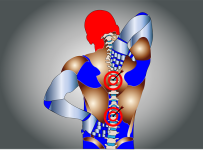
While there are more than 55 diseases linked to gluten either directly or indirectly, there are five common signs many people exhibit that are gluten intolerant:
• Digestive Issues
• Mood Changes
• Joint Aches
• Skin Issues
• Brain Fogginess
Let’s look into them in a bit more detail.
Digestive Issues
A gluten intolerance shows up most commonly as gas, bloating, and either constipation or diarrhea after eating foods containing gluten – a nutrient found in wheat rye and barley. Many people diagnosed with Irritable Bowel Syndrome do considerably better once they stop eating gluten. In children, it usually shows up as constipation.
Mood Changes
Because gluten causes hormonal imbalance, mood changes like depression, anxiety and ADD worsen after eating a food containing gluten. These symptoms usually improve once gluten is taken out of the person’s diet.
Joint Aches
Gluten intolerance can cause inflammation which shows up as joint pain in some people. The fingers and knees seem to be particular sensitive to gluten intolerance.
Skin Issues
Known as Keratos Pilaris, a sensitivity to gluten can show up as raised bumps on the skin (known as chicken skin) caused by the malabsorption of fatty acids and vitamin A. The malabsorption is caused by damage to the intestines do to long-term exposure to gluten. Other skin issues such as dandruff, is actually eczema of the scalp. Many people also develop and itchy rash as part of their skin issues.
Brain Fogginess
This can range from just thought sluggishness to outright forgetting to do things. You might have trouble concentrating or focusing on things and may even have short-term memory lapses. Losing your train of thought when writing or conversing is common as is becoming disoriented or confused in extreme cases.
Testing for Gluten Intolerance
One of the best ways to test for gluten sensitivity is to eliminate it entirely from one’s diet – 100% absent for two weeks to a month. If you feel better without eating gluten, you are most likely gluten intolerant.
While it is relatively easy to not eat foods known to have gluten, such as wheat, rye or barley in pastas, breads, cakes, cookies, crackers, and cereal, it gets more difficult when purchasing foods or eating out in a restaurant. Quinoa, amaranth and millet are three good gluten-free grain substitutes.
When purchasing packaged food, read the ingredients label. Sometimes it shows up in foods you would not expect to have gluten. When eating out, explain you are gluten sensitive and ask if your entrée or meal contains gluten. Many stores and restaurants make note what is gluten-free in their offerings.
Extreme gluten intolerance, known as celiac disease, can be quite serious; even eating gluten for the extreme intolerant once a month increases their risk of death by 600%!














